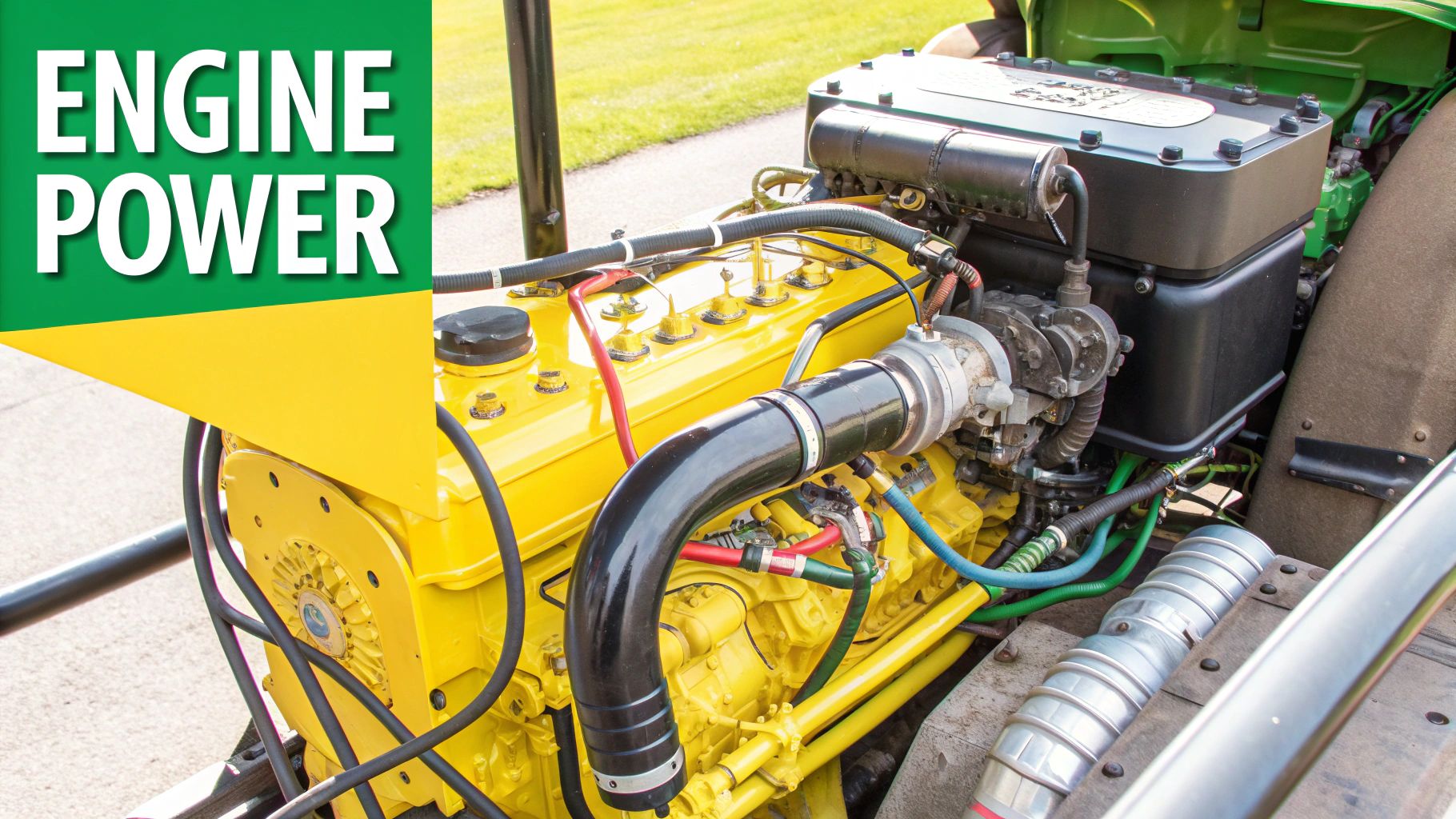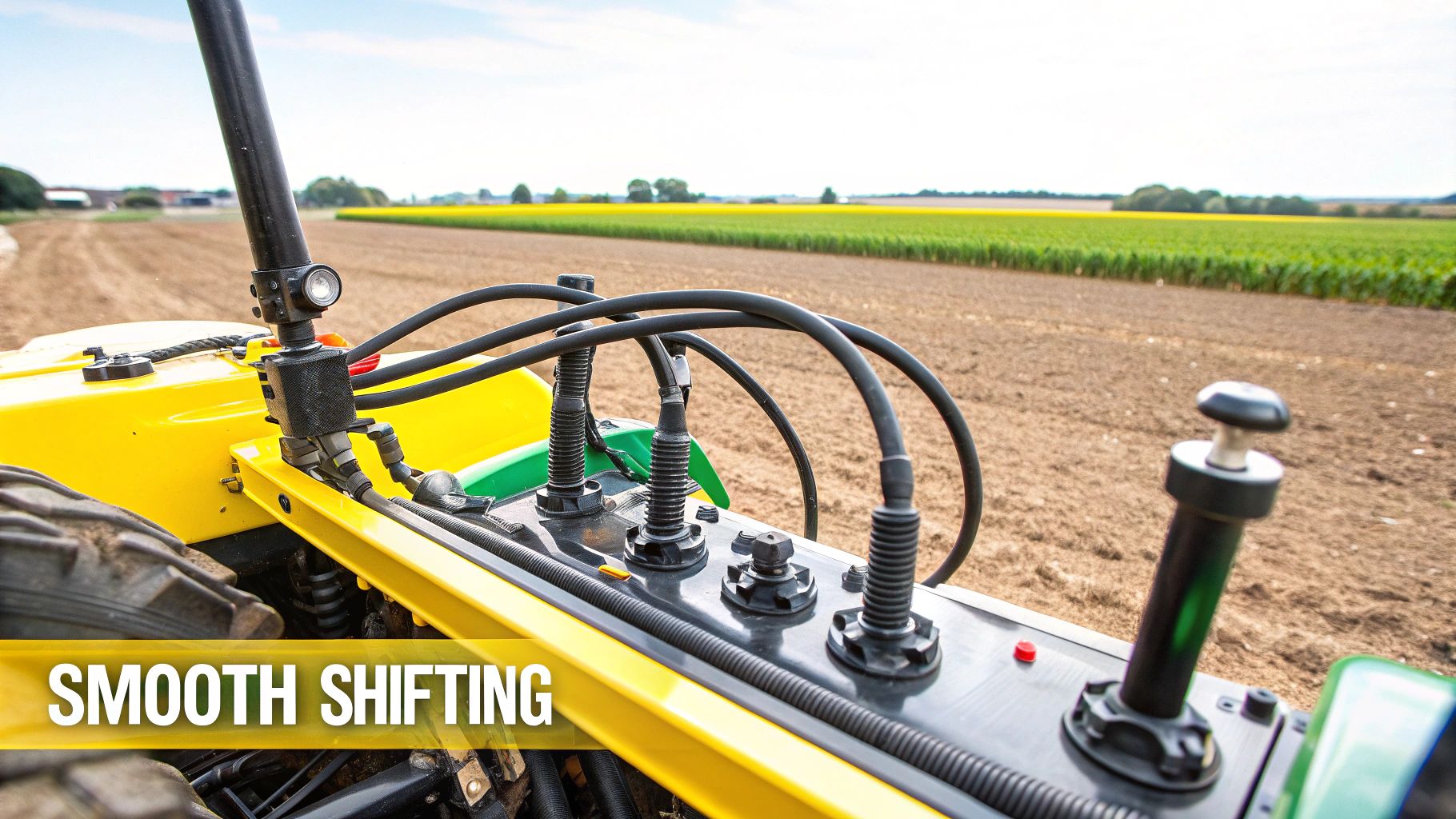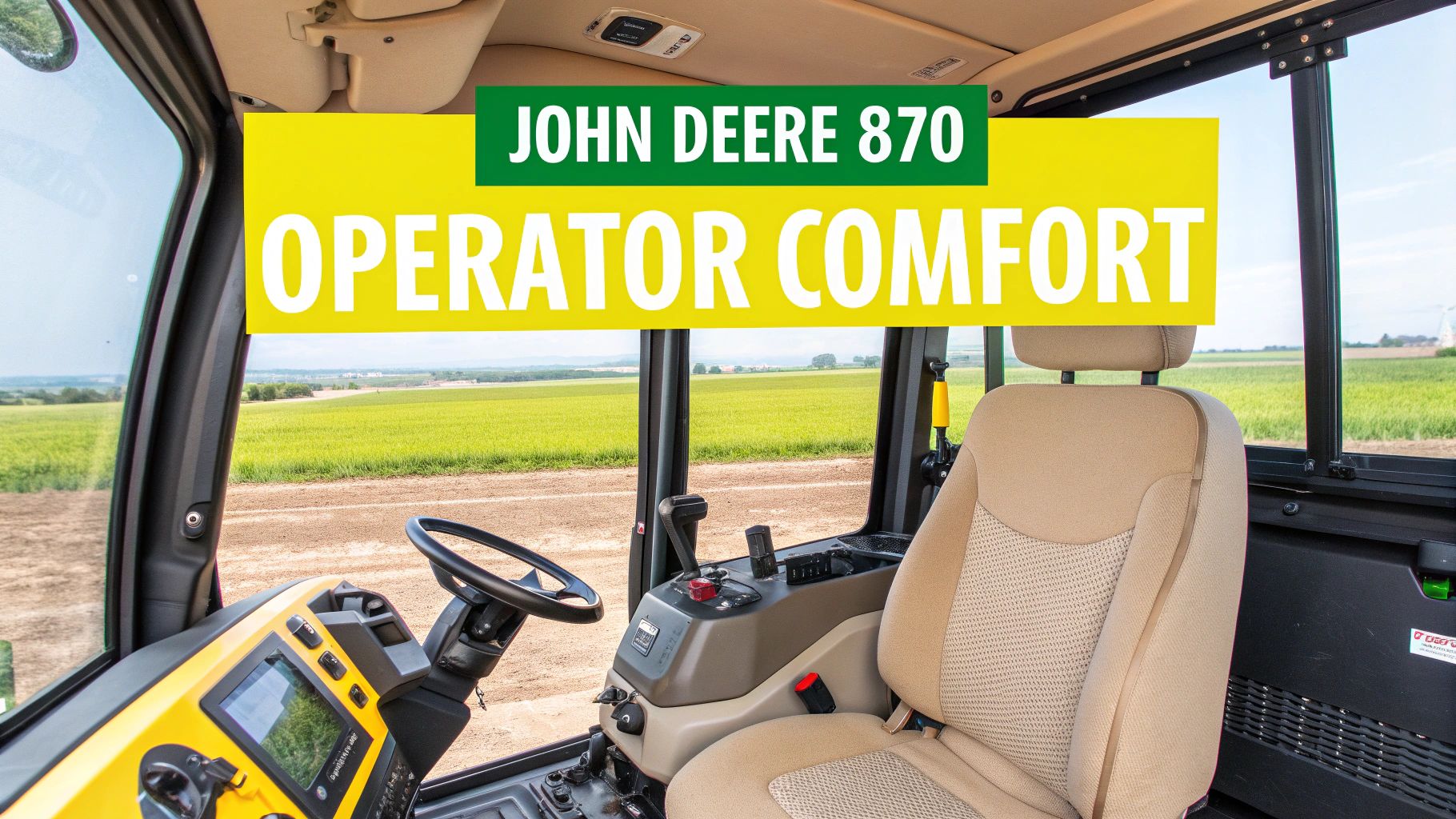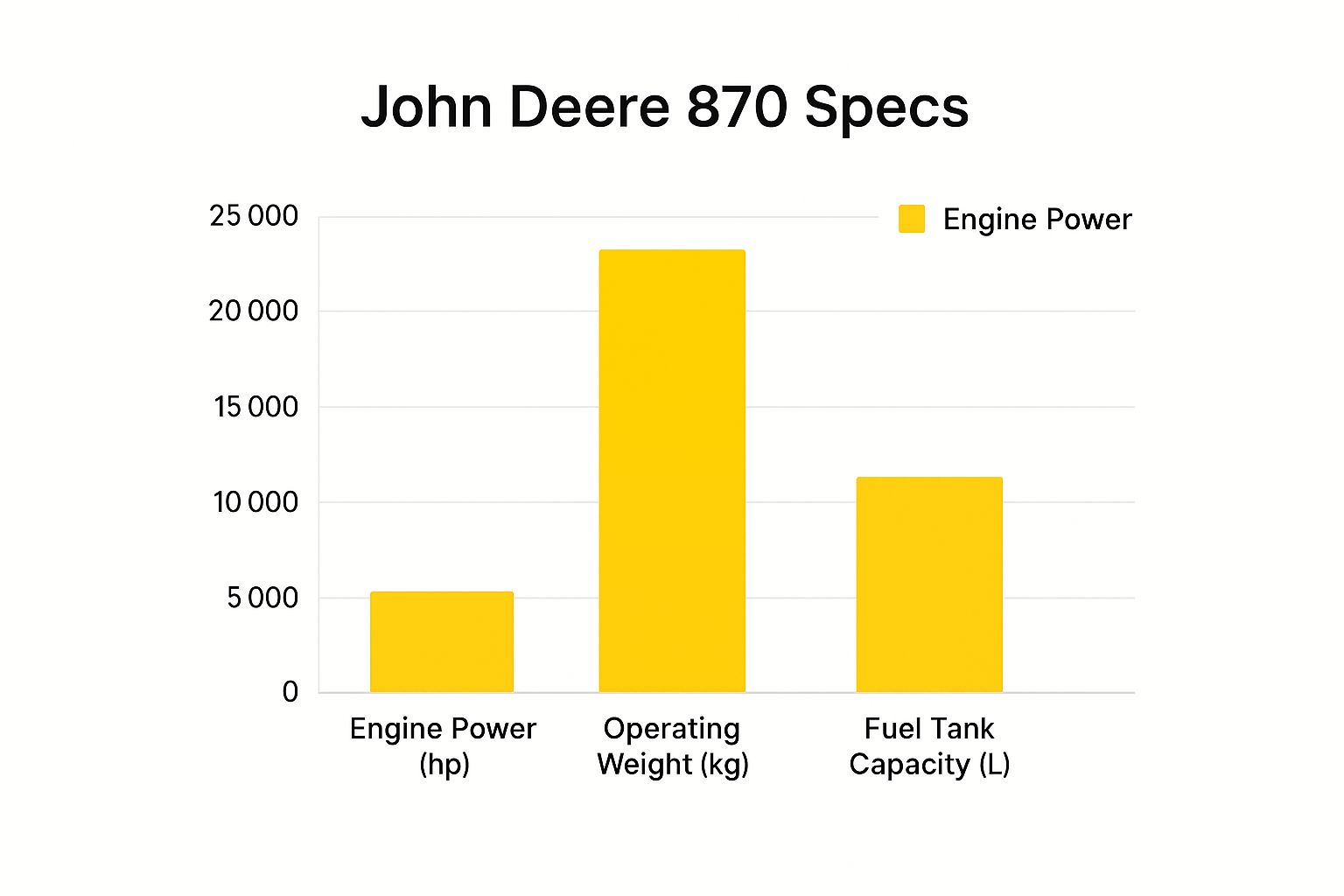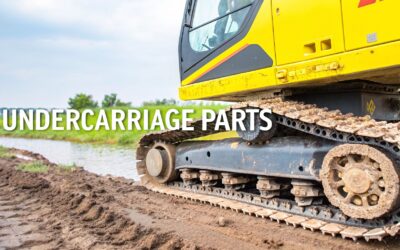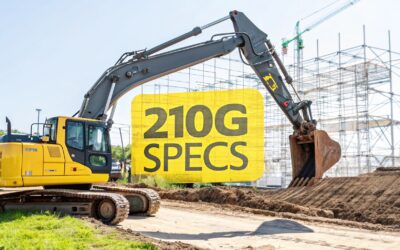The John Deere 870 has earned its reputation as a dependable workhorse in the compact utility tractor class. Powered by a tough 28-horsepower Yanmar diesel engine and matched with a straightforward gear transmission, it provides operators a solid, no-frills machine for getting work done efficiently.
Equipped with a standard Category 1 three-point hitch and a reliable 4×4 drivetrain, the 870 is more than capable of handling a wide range of property maintenance and agricultural tasks. This guide breaks down the key John Deere 870 specifications and performance data, offering actionable insights for landowners and project managers who rely on this kind of equipment.
At a Glance: John Deere 870 Specifications
When comparing tractors, the core specifications tell the real story. The John Deere 870 was built to hit the sweet spot between raw power and nimble maneuverability. This balance makes it a favorite for small-scale farmers, construction site managers, and landscapers who need a reliable machine for mowing, tilling, and moving materials. Its simple, rugged design is a key reason for its staying power on the used market. It is a machine built to last.
Of course, the 870 is designed for firm ground. If your projects involve wetlands, swamps, or other soft terrain, you are in a different league of equipment altogether. For challenges like pipeline installation or environmental cleanup in saturated conditions, you can explore a variety of amphibious equipment models to see how specifications are radically different for extreme environments. Here, we will focus on the 870, giving you the hard numbers to understand exactly what it can do on solid ground.
Detailed Engine and Performance Metrics
At the heart of every John Deere 870 lies the venerable Yanmar 3TN84 diesel engine. This 3-cylinder, liquid-cooled powerhouse gives the tractor its muscle, reliably delivering consistent power for everything from the drivetrain to the hydraulics. To understand what this machine can truly accomplish, you have to start with the engine specs.
The tractor was rated to produce a solid 28 horsepower (20.9 kW) at 2600 RPM, providing more than enough strength to handle common implements like mowers, tillers, and small front-end loaders. First introduced in 1989, this engine was built to last, featuring a displacement of 87.3 cubic inches and a 17.8:1 compression ratio. This combination speaks to both its fuel efficiency and its overall durability. For those who enjoy a deep dive, you can find more on the Yanmar 3TN84 engine on iFixit.
Key Engine Specifications
While horsepower gets all the attention, a few other numbers really tell the story of this engine’s design and character.
- Bore and Stroke: The engine has a bore of 3.31 inches and a stroke of 3.39 inches. This nearly "square" design is a classic engineering choice for balancing horsepower and torque effectively.
- Cooling System: It’s liquid-cooled, which is essential for maintaining stable operating temperatures. This is a critical feature for anyone planning long workdays, as it directly contributes to engine longevity and prevents overheating during demanding tasks like land clearing.
- Fuel System: The Yanmar uses a direct injection fuel system, a design known for promoting efficient combustion and getting the most out of every drop of diesel.
These specifications are ideal for a tractor designed for solid ground. When you're working in saturated environments like swamps or marshlands, you are in a completely different league of machinery. The requirements change dramatically when you look at something like a modern amphibious excavator, where flotation and hydraulic power become the primary metrics for success.
Understanding the Drivetrain and Transmission
A tractor's real-world performance hinges on its ability to transfer engine power to the ground effectively. The John Deere 870 accomplishes this with a straightforward, rugged gear-driven system built for durability and direct control. For operators who need reliable torque for tough, ground-engaging work, this kind of mechanical setup is exactly what you want.
The unsynchronized transmission offers eight forward gears and two reverse gears. This setup provides a wide array of speed and power combinations, allowing you to fine-tune your approach for any task. You can crawl along with maximum pulling power for tilling or shift up for quick transport across a property. This granular control is a standout feature in the John Deere 870 specifications that seasoned operators value.
Enhancing Traction and Stability
To master tricky or uneven ground, the 870 comes equipped with critical features designed to maximize its grip and maneuverability. These systems are the difference-makers on soft soil, steep grades, or in muddy conditions where a standard two-wheel drive tractor would quickly become stuck.
- Mechanical 4WD: The on-demand four-wheel drive (4WD) is a game-changer. Engaging it sends power to all four wheels, dramatically increasing your traction when you need it most.
- Differential Lock: When one of the rear tires starts to slip, the differential lock forces both rear wheels to rotate at the same speed. This simple, effective mechanism prevents the free-spinning wheel from digging in and keeps you moving forward.
When you combine the selectable gear ranges with the 4WD system, you get a tractor that can adapt to almost anything, from maintaining a perfectly consistent speed for a quality mowing job to digging in and delivering raw pulling power to break new ground.
A Look at the Hydraulic System and Lift Capacity
The real muscle behind the John Deere 870 is its hydraulic system. This is what powers the three-point hitch and any attachment you hook up, so getting a handle on its specs is key to knowing what the tractor can actually do on your project site. The 870 uses a straightforward and reliable open-center hydraulic design, which was the go-to for tractors in this class.
The system pushes a total hydraulic flow of 6.1 gallons per minute (23.1 lpm). This number is a big part of the overall John Deere 870 specifications because it dictates how quickly your implements, like a front-end loader or backhoe, will respond. Paired with a system pressure of 2275 psi, it has the force needed to move heavy materials and run demanding tools.
Three-Point Hitch and Implement Power
Out back, the 870 features a standard Category 1 three-point hitch. This is the universal connection point for the vast majority of implements designed for compact tractors. But the hitch is only as good as its lifting power.
- Rear Lift Capacity: The 870 can hoist 1,150 lbs (521 kg) at the lift points. This gives you plenty of strength for common tools like a box blade, a rotary tiller, or a good-sized brush hog.
This lift capacity makes the 870 a solid performer for tough landscaping jobs, property upkeep, and even small farming tasks. It's interesting to see how this same fundamental hydraulic power gets adapted for more specialized machines. For instance, the principles that allow an 870 to lift a tiller are scaled up to drive popular marsh runner attachments in extreme, amphibious conditions, solving complex challenges in dredging and land reclamation.
Power Take-Off (PTO) Capabilities and Applications
The Power Take-Off, or PTO, is the heart of the John Deere 870's versatility. It's the system that takes raw engine power and channels it directly into whatever implement you have hooked up, turning this tractor into a true multi-tool for the field or property. Understanding its PTO specs is key to ensuring you are pairing the right attachment with the job at hand.
At its core, the 870 features a live PTO, which is a fantastic feature because it operates independently of whether the tractor is moving. It sends a respectable 24 horsepower straight to the implement. That figure is a critical part of the overall John Deere 870 specifications and provides more than enough muscle for most common attachments.
PTO Specifications and Common Uses
The PTO system on the 870 was clearly designed for reliability and compatibility with a wide range of tools you would use for farming, landscaping, and property maintenance.
Here are the key specs to know:
- PTO Type: It’s a live, transmission-driven PTO. This means you can engage or disengage it on the fly, a big step up from older systems.
- Rear PTO Speed: The 870 runs at the industry-standard 540 RPM.
This standard setup is perfect for powering implements like rotary tillers, finish mowers, post-hole diggers, and even smaller square balers. The consistent power delivery from the live PTO ensures these tools work exactly as they should.
Of course, this tractor is built for solid ground. It is interesting to compare its straightforward mechanical power delivery to highly specialized equipment. For instance, an amphibious dredge unit operates in a completely different world, relying on complex hydraulic systems to power its tools in wet, challenging conditions. It just goes to show how different engineering solutions are developed for specific environments.
Physical Dimensions, Weight, and Stability
When sizing up a tractor, its physical footprint is every bit as important as what is under the hood. The John Deere 870 was built on a compact frame, a deliberate design choice that gives it fantastic maneuverability without making it feel tipsy. This makes it a great fit for weaving through tight spaces or working on uneven ground.
Knowing these numbers is key for everything from transport and storage to simply making sure it can get through a gate on a construction site.
The tractor's weight is a major factor in both traction and how much pressure it puts on the ground. The 870 sits on a wheelbase of 67.5 inches (171 cm) and tips the scales at around 2,500 pounds (1,134 kg), which is fairly light for a tractor of its capability. That light weight does not hold back its muscle, though, it boasts a loader lift capacity of roughly 920 pounds (417 kg) to full height. You can always review its historical sales data to get a better sense of its real-world performance.
Key Dimensions and Capacities
These specs are the bread and butter for figuring out if the 870 can handle the materials you need to move. It strikes a good balance between its own weight and what it can lift, which is exactly what you want for stable, efficient work.
- Overall Length: About 114.6 inches (291 cm) with the three-point hitch attached.
- Overall Width: This can change depending on your tires, but it is typically around 56.5 inches (143 cm).
- Height to ROPS: The top of the rollover bar stands at 83.5 inches (212 cm), a critical number to remember when parking it in a garage or shed.
Beyond the machine's own footprint, you also have to think about getting it from point A to point B. Understanding heavy equipment shipping rates is a practical reality for any owner. Thankfully, the 870's manageable size and weight usually mean logistics are simpler and more affordable compared to its bigger, heavier counterparts.
How the 870 Stacks Up Against Other Compact Tractors
To really get a feel for the John Deere 870's capabilities, it is useful to see how it measured up against the competition. Back when it was in production, the compact utility tractor market was a crowded field. The 870 managed to carve out a solid reputation by focusing on a balanced design that delivered reliability and practical power, rather than just chasing the highest numbers on a spec sheet.
Putting it head-to-head with other tractors from that era, you will often find the 870 had a better power-to-weight ratio. While some rivals might have boasted a few extra horsepower, that often came with a heavier, more cumbersome frame. This balance made the 870 a go-to choice for jobs that needed both muscle and agility, like landscaping in tight yards or working on delicate turf where you could not afford to leave deep ruts.
This graphic breaks down some of the 870's most important specs, like its engine output, weight, and fuel tank size.
As you can see, its sensible weight combined with an efficient engine created a truly well-rounded machine for its time.
John Deere 870 vs. Competitor Models
To provide a clearer picture, let's look at a side-by-side comparison. This table puts the 870's key metrics against what you might find in similarly sized tractors from the same period. This kind of direct comparison is invaluable when you're shopping the used market and weighing your options.
| Specification | John Deere 870 | Competitor A | Competitor B |
|---|---|---|---|
| Engine Horsepower | 24 HP | 25 HP | 23 HP |
| PTO Horsepower | 20 HP | 21 HP | 19.5 HP |
| Operating Weight | 2,015 lbs | 2,250 lbs | 1,980 lbs |
| 3-Point Lift Capacity | 1,150 lbs | 1,100 lbs | 1,200 lbs |
| Hydraulic Flow | 6.1 GPM | 5.8 GPM | 6.3 GPM |
While the numbers are close, the 870 consistently hits a sweet spot. It offers competitive lift capacity and hydraulic performance in a lighter, more agile package than many of its rivals, which is a key reason for its lasting popularity.
Key Competitive Differences
When you are looking at a used 870, these are the areas where it really set itself apart from the pack. Keep these points in mind as you compare it to other models you might be considering.
- Hydraulic Flow: The 870's hydraulic system pushed a respectable 6.1 GPM (gallons per minute). For its day, this was a solid flow rate that gave operators responsive and reliable control over implements like loaders and backhoes.
- Lift Capacity: With a rear 3-point lift capacity of 1,150 lbs, this tractor could easily handle a wide variety of Category 1 attachments. It had enough muscle for box blades, rotary cutters, and post-hole diggers without putting undue stress on the machine.
- Drivetrain Simplicity: Many operators appreciated the simple, robust gear transmission. Compared to some of the early, more complex hydrostatic systems on competing tractors, the 870's gearbox was known for its durability and straightforward maintenance, a huge plus for owners who do their own repairs.
Matching Equipment Specs to Demanding Environments
Knowing the John Deere 870's specifications is one thing, but translating those numbers to the reality of your work environment is where success is truly determined. A tractor's impressive lift capacity or PTO horsepower means very little when the ground is saturated. In challenging terrains like wetlands, swamps, or riverbeds, you are dealing with a completely different set of rules.
For projects in these kinds of conditions, you have to look beyond conventional equipment. Standard machinery simply cannot operate in dredging, pipeline installation, or environmental cleanup scenarios. This is where specialized amphibious equipment, engineered with high flotation and low ground pressure, becomes non-negotiable. At Wilco, we take a detail-oriented approach to specifications when building custom amphibious excavators and undercarriages that thrive where a standard tractor would fail.
From Solid Ground to Water: A Shift in Priorities
Whether you are working a farm field or a marsh, the core idea is the same: the right specs deliver the right results. The difference is that the environment completely changes the engineering priorities.
- Stability and Flotation: Instead of focusing on wheelbase and tire size, our attention shifts to pontoon design and total surface area. The goal is to distribute the machine's weight effectively to prevent it from sinking.
- Propulsion: The traditional gear transmission of a tractor like the 870 is swapped out for robust hydraulic systems. These systems power excavator-style tracks that provide real traction and mobility through thick mud and standing water.
No matter the equipment, a solid understanding of preventive maintenance is fundamental to ensuring peak performance and a long service life, especially when operating in harsh conditions.
When your work takes you off solid ground, you need a partner with proven expertise in amphibious solutions. At Wilco Manufacturing, we design and build custom-engineered equipment to conquer your most challenging projects in construction, dredging, and environmental cleanup. Contact our team to discuss your equipment needs and see how our amphibious machines can provide the solution. You can learn more at https://wilcomfg.com.
